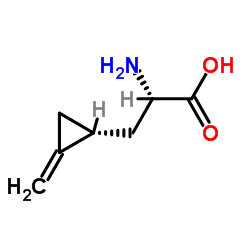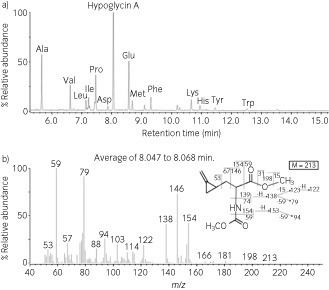Formula C7H11NO2 Melting point 282 °C | Molar mass 141.17 g/mol | |
 | ||
Hypoglycin A is a naturally occurring amino acid derivative found in the unripened fruit of the Ackee tree (Blighia sapida). It is toxic if ingested, and is the causative agent of Jamaican vomiting sickness. A 2017 Lancet report established a link between the consumption of unripened lychees (containing hypoglycin A or methylenecyclopropylglycine (MCPG)) resulting in hypoglycaemia and death from acute toxic encephalopathy.
Contents

Toxicity

Hypoglycin A is a type of Trojan Horse Inhibitor, also known as a Suicide Inhibitor, that in itself does not inhibit any biochemical pathway. However, when mistaken for a branch chain amino acid, the toxicity arises from its metabolites. The branched-chain alpha-keto acid dehydrogenase complex, that would normally convert leucine, isoleucine, or valine into Acyl-CoA derivates, takes this hypoglycin A and metabolizes it into toxic inhibitors; methylene cyclopropyl acetic acid and methylenecyclopropane acetyl esters with carnitine and coenzyme A. The FAD prosthetic group necessary for the beta oxidation of fatty acids associates with the alpha carbon of MCPA-CoA creating an irreversible complex that inhibits the activity of acyl CoA dehydrogenase. In addition, MCPA-CoA blocks some enzymes that are required for gluconeogenesis.

The reduction in gluconeogenesis and the reduction in fatty acid oxidation are thought to be the cause of most of the symptoms of Jamaican vomiting sickness. The blocking of fatty acid metabolism causes cells to start using glycogen for energy. Once glycogen is depleted, the body is unable to produce more, which leads to a severe case of hypoglycemia. These biochemical effects are detected by an excess of medium chain fatty acids in urine and acidosis. Key treatments are aimed at circumventing or counteracting the biochemical changes, and include IV fluids and glucose, and hemodialysis in the case of renal failure.
Synthesis

In 1958, John Carbon, William Martin, and Leo Swett were the first to synthesize hypoglycin, in racemic form, starting from 2-bromopropene and ethyl diazoacetate to form the cyclopropane ring.



